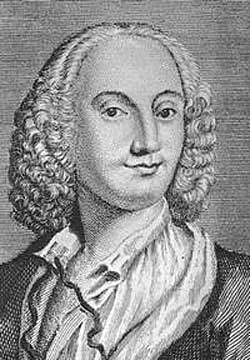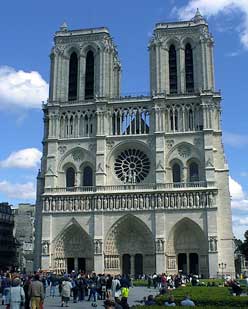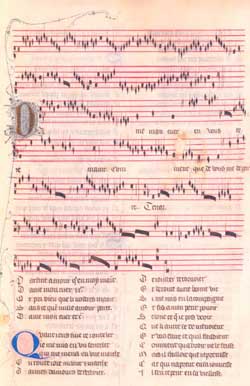|
|
|
 Guillaume de Machaut
Guillaume de Machaut began composing for John of Luxembourg, King of Bohemia after he became the king’s royal secretary (c. 1323). Machaut became the canonry of the cathedral in Reims, France in 1335. He held this position until the king died in battle. From here Machaut continued his composing for various French high nobleman, such as John, Duke of Berry. Towards the end of his life in his last stage of composition, Machaut compiled all of his works together. Because of these compilations, we can see the progress and stages of his works and contrapuntal techniques.
During the fourteenth century, there was a wave throughout France called the Ars Nova. This means the new art (forms). Along with writers like Dante and Chaucer and painters like Giotto, Machaut became a major influence to many other composers. The art was about movement and grace. From the literature that has showed up in his secular songs, one can find emerging forms fixes-standard verse patterns. The French lyric poetry from the above (or previously mentioned) writers can be seen in the text of his secular songs. Most of all, from Ars Nova came syncopation and the art of precise rhythmic notation. It allowed composers to write in 4 versus the 3 beats per measure, which all music prior was written in. This allowed for more exploration through composition. Franco of Cologne was the person who is associated with this concept of precise rhythmic notation. He was a mid-13th century German composer.
The most famous Mass that he wrote is the: Notre – Dame Mass {or also known as the Messe de Nostre Dame}, which demonstrates the first attempts to use polyphonic techniques in four of the Gregorian, based isorhythmic movements of the Mass Ordinary. The Kyrie, Gloria, Credo, Sanctus, Agnus Dei– the dismissal (the Ite Missa Est – “Go The Mass Is Done,” are all unified and separated parts to this Mass. The interesting fact about this is that no composer previously had done something like this. They were written in honor of the blessed virgin. One of Machaut’s stylistic composing techniques that can be seen in some of his Mass writing, but more in his secular compositions such as his rondeaux and ballades, was his ability to use an increased awareness of tonality and use of unifying rhythmic motifs.
Lets dissect the Agnus Dei as did the Norton Anthology Of Western Music: Medieval, Renaissance and Baroque; Volume I, Edited by Claude V. Palisca, W.W. Norton & Company, New York, 1980.
 Notredame Cathedral, Paris
Agnus Dei, qui tolis peccata mundi,
Lamb of God, who take away sins of world,
miserere nobis.
have mercy on us.
Agnus Dei, qui tolis peccata mundi,
Lamb of God, who take away sins of world,
dona nobis pacem.
grant us peace.
The interesting fact about this piece is the text painting that is presented in this piece. Agnus Dei, both words consist of a descending line, where as when it end with grant us peace the notes ascend in the Cantus I.
 Machaut's Medieval Lyric
1. Guillaume de Machaut Messe de Notre Dame: Hyperion CDA 66358: Ma fin est mon commencement;.
2. Codex Faenza. Italie XVe siècle: Harmonia Mundi HMC 901354: O ciecho mondo di lusinghe pieno;.
3. Messe de Notre Dame: CDA66358: Ma fin est mon commencement;.
4. Il Solazzo: music for a medieval banquet: Harmonia Mundi 907038: Donna, s'i' t'[h]o fallito;.
5. The History of Music in Sound. Vol. III. Ars Nova and the Renaissance: HMV HMS 20-31, 21=(78rpm mx. 2EA 15609-1B): Ma fin est mon commencement;.
Machaut also wrote virelays and motets. Virelays are several medieval French verses and song forms, especially one in which each stanza has two rhymes, the end rhyme recurring as the first rhyme of the following stanza. Motets are texted vocal forms with polyphonic notation.
Related resources:
| | - "Masterworks; A Musical Discovery, Holoman, D. Kern, Prentice Hall, Upper Saddle River, New Jersey, 1998." on Amazon.com
- "Music: An Illustrated Encyclopedia Of Musical Instruments And The Great Composers, Wade - Matthews, Max, & Thompson, Wendy, Lorenz Books; Anness Publishing, London, 2004." on Amazon.com
- "The Lives of the Great Composers; Third Edition, Schonberg, Harold C.,W.W. Norton Company, New York, 1997." on Amazon.com
|
The contents, views and opinions in this article are those of its author.
|
|
|
|
|
|